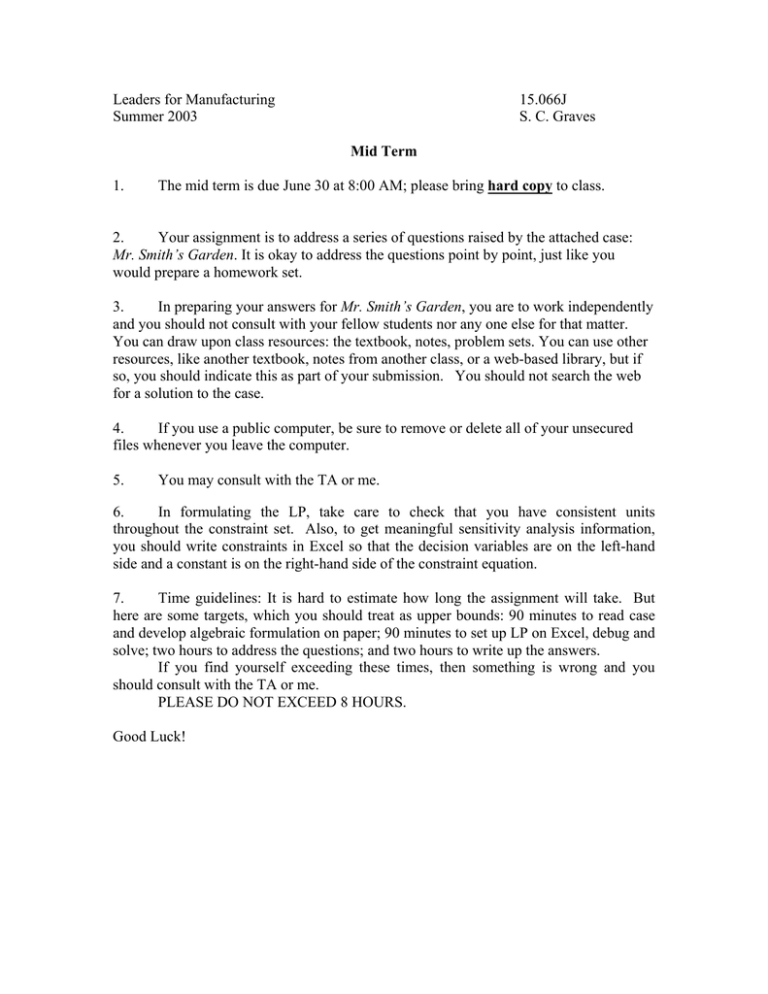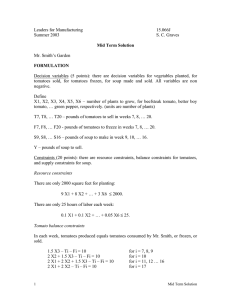Leaders for Manufacturing 15.066J
advertisement

Leaders for Manufacturing Summer 2003 15.066J S. C. Graves Mid Term 1. The mid term is due June 30 at 8:00 AM; please bring hard copy to class. 2. Your assignment is to address a series of questions raised by the attached case: Mr. Smith’s Garden. It is okay to address the questions point by point, just like you would prepare a homework set. 3. In preparing your answers for Mr. Smith’s Garden, you are to work independently and you should not consult with your fellow students nor any one else for that matter. You can draw upon class resources: the textbook, notes, problem sets. You can use other resources, like another textbook, notes from another class, or a web-based library, but if so, you should indicate this as part of your submission. You should not search the web for a solution to the case. 4. If you use a public computer, be sure to remove or delete all of your unsecured files whenever you leave the computer. 5. You may consult with the TA or me. 6. In formulating the LP, take care to check that you have consistent units throughout the constraint set. Also, to get meaningful sensitivity analysis information, you should write constraints in Excel so that the decision variables are on the left-hand side and a constant is on the right-hand side of the constraint equation. 7. Time guidelines: It is hard to estimate how long the assignment will take. But here are some targets, which you should treat as upper bounds: 90 minutes to read case and develop algebraic formulation on paper; 90 minutes to set up LP on Excel, debug and solve; two hours to address the questions; and two hours to write up the answers. If you find yourself exceeding these times, then something is wrong and you should consult with the TA or me. PLEASE DO NOT EXCEED 8 HOURS. Good Luck! Questions for Mr. Smith’s Garden. a. Possibly a linear program might be the best way to address Mr. Smith’s concerns. Formulate this problem using the data in the case and then solve it (presumably with Excel). You should state the algebraic formulation and be sure to define clearly all of the decision variables, constraints and objective function. You should then convey to Mr. Smith what he should plant in order to meet his requirements and maximize his profit from his garden. To answer this, DO NOT WORRY about the integrality of the decision variables – the garden is very big and it’s okay to plant fractional bushes for the purposes of this exercise. The following questions are to be addressed independently. b. c. d. e. f. If Mr. Smith could hire up to another 5 hours of labor per week at $15 per hour, should he do this? Why or why not? Suppose Mr. Smith could rent another 500 square feet to add to his garden. What is the value of this? What would he use it for? Suppose Mr. Smith would be willing to buy tomatoes at the market price during the season for his own consumption, and for meeting his need for frozen tomatoes. Would he want to do this? Why or why not? Suppose Mr. Smith has an opportunity to sell an additional 200 pounds of soup at $3 per pound. Should he agree to this contract? How would his garden plan change? How long did you spend on the exam? Grading – 50 points for part (a), and the remaining 50 points divided roughly equally over parts (b) through (e). NOTE – FOR ALL QUESTION, DO NOT WORRY ABOUT THE INTEGRALITY OF THE DECISION VARIABLES. IT IS OKAY TO HAVE FRACTIONAL SOLUTIONS. Mr. Smith’s Garden Mr. Smith is an avid gardener, and each spring he must plan what to plant in his vegetable garden. He grows tomatoes, eggplants, zucchini and green peppers. He would like his garden to provide a rich harvest of these vegetables so that he has fresh vegetables throughout the late summer and fall, as well as frozen vegetables for the winter. It is now June 1, 2003, and he is about to go to the local nursery to pick the vegetables to plant. He has constructed the table below to help decide what to plant. Beefsteak tomato Better Boy tomato Rutgers tomato Eggplant Zucchini Green Pepper Length of harvest (weeks) 10 Yield per week per plant (pounds) 2 0.1 9 2 8 7 0.15 6 1.5 10 8 10 3 0.05 0.05 0.05 8 6 8 1 3 1 8 10 10 Square feet per plant Hours per week Weeks until first harvest 9 0.1 8 10 From past experience he has identified three types of tomatoes to consider growing, along with his eggplant, zucchini and green pepper. For each vegetable, he needs to decide the number of plants to grow. Each plant will occupy a certain amount of area in the garden, as noted in the second column. His garden is 2000 square feet in total. Also, each plant requires a certain amount of labor each week (third column), to weed, fertilize, water and harvest. For instance, each Beefsteak tomato plant requires 0.1 hour per week. This labor requirement starts when it is planted, and won’t end until the end of the harvest, 20 weeks later (i.e., the labor requirements continue even after the plant stops yielding produce.). Mr. Smith hires a neighborhood girl at $8 per hour to do this work for him. However, he expects that the neighborhood girl has only 25 hours to work each week, as she is also attending summer school. Mr. Smith plants the entire garden on June 1. The fourth column indicates how many weeks until he gets the first fresh vegetables from each plant type. Once the plant is yielding vegetables, he estimates that he can harvest a fixed number of pounds per week, as given in the fifth column. This harvest will go for a number of weeks, as noted in the sixth column. For instance, a Rutgers plant produces 1.5 pounds of tomatoes each week for a ten-week period, namely from week 7 through to week 16. The growing season is from week 7 to week 20. During the growing season Mr. Smith will consume 10 pounds of fresh tomatoes each week. He insists on eating those that he grows. In addition to eating his tomatoes, each week Mr. Smith has the option to freeze fresh tomatoes for use in the winter. By week 20, he needs to have 250 pounds of frozen tomatoes. The tomatoes that he freezes must come from his garden; he will not buy tomatoes for this use. Any leftover tomatoes can be sold at the market at the market price. He expects that the market price will be $4 per pound for week 7, and then will drop in price by $.20 per pound every week thereafter. Thus, he expects in week 20 the price per pound will be $1.40. Mr. Smith uses the other vegetables to make vegetable soup that he stores for consumption in the winter. His recipe calls for 1 pound of zucchini and 2 pounds of green peppers for every pound of eggplant; this recipe will make 4 pounds of soup. To make the soup, all of the vegetables must be fresh; that is, the vegetables were picked in the same week that the soup is made. By the end of the season, he needs to have 200 pounds of soup prepared for the winter. Any leftover vegetables can be used to make more soup to be sold at the market. Mr. Smith expects that he will be able to sell up to 2000 pounds of soup for $5 per pound. Excess eggplants, or zucchini or green peppers cannot be sold and are put into the compost pile.


